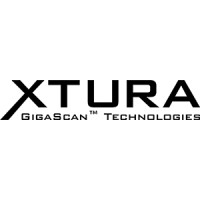The GigaScan™ is a highly flexible targetless 3D capture technology. This flexibility lends itself to being ideal for a wide range of suitable scenarios. Here at XTURA we will work side-by-side with you to develop a bespoke inspection solution for your specific needs, using GigaScan™ technology.
The core components of a GigaScan™ powered solution are:
Imaging Sensor: With our expertise, we carefully select the ideal imaging sensors (typically industrial grade digital cameras) for your needs. We then custom calibrate and lock these devices for optimised and robust use within our photogrammetry algorithms. XTURA partners with Canon, but has flexibility to offer other supplier equipment depending on your needs.
- Controller Unit: Imaging sensors are all managed via the XTURA system controller unit which ensures images are captured with the correct timing for the inspection process. This unit is also bespoke built with multiple GPUs and optimised for rapid 3D photogrammetry reconstruction.
Contact – https://www.gigascan-technologies.com/contact-xtura

The XTURA team will take you through a process to initially identify your application objectives, then working closely together, XTURA will design the GigaScan™ powered solution to fulfil your exact requirements. We blend the GigaScan™ technology with any additionally required physical infrastructure (frameworks, fixtures, rigs, robotics etc), plus any analysis software needed to complete the end-to-end solution.

GigaScan™ greater than the sum of its parts
Typical Applications
GigaScan™ powered solutions are ideally suited to deliver automated, repetitive surface or feature inspection tasks. Some examples of existing installations include:
- Foundry raw material inspection to micron accuracy if needed. With an unlimited number of cameras in fixed locations processing to give a pass/fail output for just in time analysis or to speed up the machine time to finished product.
- Bespoke integration with major brand cobots, using a single camera for pressed sheet steel inspection in a production line. Single-camera on a robot or multi-position cameras in fixed locations processing to give 2D/3D pass/fail output for just in time measurement.
- GigaScan™ 3D Software: This is the ‘engine’ used to process the image data to reconstruct to 3D within the Controller unit. XTURA has spent many man-years developing and optimising its algorithms both for accuracy of 3D output and also efficiency of processing. The result is world leading, and needless to say, is completely unique to XTURA.

Production Line or Outdoors
Advantages
GigaScan™ powered inspection solutions:
- No targets. Targetless photogrammetry means exactly that. Unlike many other metrology technologies, there is no need to apply targets to the surface of the item you wish to capture.
- No surface preparation. Because our approach uses the inherent texture in the material, structure or surface finish of your object, we do not require additional coatings, like projected light systems often do.
- Choose your accuracy. Yes, we really mean that. Unlike other metrology technologies which have a strictly limited accuracy, the potential accuracy provided from GigaScan™ powered solutions is largely a function of the design of the system, until reaching low micron levels at least. We can tune the system (for example, increase input imaging resolution and coverage) to meet the required output precision, resolution and inspection speed.
- No localisation needed. Many other inspection or metrology techniques require highly accurate positioning or tracking of the sensor to be able to create the global system alignment. GigaScan™ technology ONLY requires the sensors to be orientated to view the subject or feature, with zero requirement to have that camera position known accurately.
- Flexible ‘rig’ design. For the above reasons, we have unbeatable flexibility with how we can design our system ‘rig’, whether a fixed frame, a robot, a cobot, a moving rail, a wired track, or anything else we can position the camera with.
- Speed vs cost. The above flexibility means we can often choose how to prioritise increased inspection speed versus solution cost, depending on the use-case requirements. I.e. we can achieve identical data outputs with one camera moved to multiple positions as we can by setting up multiple cameras to trigger simultaneously from those same positions. We can also apply increased processing power to reduce processing time where required, or run smaller lower cost processors where time of reconstruction is less critical.
- Design for robustness. Fundamentally, targetless photogrammetry does not require the same degree of complexity at the capture phase of the process, compared to other metrology approaches such as projected light or contact measurement. This means inherently higher levels of robustness to environmental factors that may be otherwise problematic.









